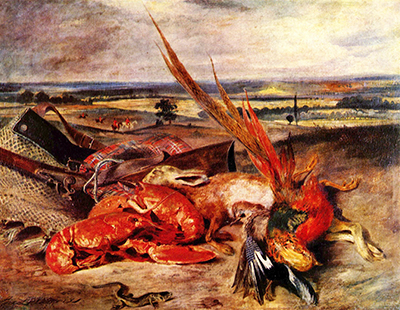This intriguing still life artwork was produced by Eugene Delacroix in 1826-27. It now resides within the Musée du Louvre in Paris, France. The artist mastered many different genres within his career and would often combine several of them together within the same composition, just as found here.
This painting was produced in Beffes, which is a small region in the Loire Valley in France. The artist was asked to produce this painting specifically for General Coetlosquet at around the same time that he also produced Death of Sardanapalus. Delacroix described Still Life with Lobsters as his 'animal painting' in correspondence with a friend. It is also believed that this artwork displays elements of the style of John Constable whose own style was typical of the English School. Delacroix put landscape scenes in many of his artworks, and even managed to do so here within a still life piece. It is interesting to see how English art influenced the French, as normally the discussions are around impacts in the opposite direction. It is worth noting how Turner was also said to have influenced Monet significantly too, with the Frenchman seeing his work in London art galleries during several visits there.
It is important to remember that the artist had himself visited England shortly before painting Still Life with Lobsters, and so the link to the English School cannot be passed away merely as a coincidence. Delacroix was friends with Fielding and Bonington and was always interested in discovering how other artists were working, even if he did not consider them up to his own standard. Whilst he respected those two, it was Constable who particularly pricked his interest and is believed to have left such an influence that he even re-worked one of his existing paintings, The Massacre of Scio, as a direct result of the new ideas that he had come across. Literature was also a strength of England at the time and he would derive further ideas from studying items such as the works of Shakespeare, for example.
This particular artwork is sized at 106.5cm in width by 80.5cm in height and was produced using oil in a wide variety of different tones. Visitors to the Louvre will find most major artists from the Renaissance up to the 19th century represented here, and the gallery remains the most visited art attraction in France, and one of the most in the entire world. Some of the other highlights to be found within their huge collection include famous paintings such as Mona Lisa by Leonardo da Vinci, Oath of the Horatii by Jacques-Louis David, The Raft of the Medusa by Theodore Gericault and Liberty Leading the People, which was aslo by Eugene Delacroix. In recent years the institution has opened sister galleries elsewhere in France with the intention of allowing more of the French nation to enjoy some of these paintings, as well as providing an increased display space which ensures fewer items remain hidden away in storage.




